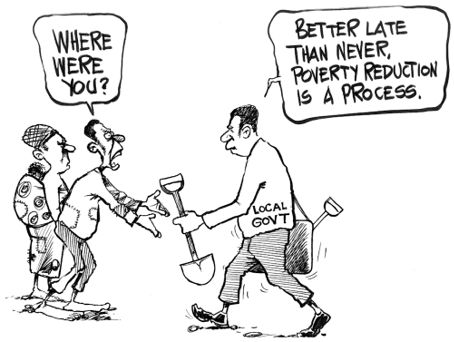 It is surprising to know that, in the months of March-April,
around 2.2 million students appeared for their X and XII public exams (and this
is only the CBSE boards without including the State boards), making the Indian
Examination system the largest of its kind anywhere in the world.
It is surprising to know that, in the months of March-April,
around 2.2 million students appeared for their X and XII public exams (and this
is only the CBSE boards without including the State boards), making the Indian
Examination system the largest of its kind anywhere in the world.
With such a staggering amount of population appearing for
exams, it is necessary for us to look at ‘standard’ of such tests being
conducted and henceforth its necessity and utility. Particularly I like to
share my current understanding on the assessment, which was inspired by article
I read an article on recently conducted Finnish Matriculation by Pasi Sahlberg.
At the premise, I want to question myself whether raising
assessment standards can increase education excellence; and it is not as simple
as setting tough question papers. And at the same time, I would like to declare
that it doesn’t mean assessment standards are panacea for our bad education
system. And at the same time, as mentioned in the Sahlberg’s article (which I
highly recommend to read before continuing), we may have to be conscious of how
this assessment is used, on teacher-designed assessments in the younger
classes, one-time nation-wide assessment only when the children attain the age
of 14 and be mindful that I am not supporting a mindless aristocratic system
which rather than being progressive in nature, reduces the trust on the
teachers.
Evidences
Given this common understanding, I like to put forth the
evidences I particularly happen to witness in coming to such a judgment.
However ill-informed or misunderstood I might be, I want this article to
challenge the existing reforms in the Education sphere and invite more such
constructive discussion on the same.
Ø
We are recently witnessing a visible decline in
the quality of Engineering graduates in Tamil Nadu. Though a variety of reasons
could be cited, experience faculty and trainers seem to site the cancellation
of TNPCEE (Tamil Nadu Professional College Entrance Exams) in the year 2005. I
personally took coaching classes on the same and remember it testing the
conceptual understanding of the students rather than on rote learning usually
being done in the regular public exams.
Ø
Visible difference in the high standard of
Engineers, Doctors coming out of IIT/ Medical colleges because of the high
standard of assessment set in the entrance exams like IIT-JEE, All India
Entrance Exams, etc. Again a high standard of assessment ensuring quality
intake into the colleges and henceforth better graduates
Ø
Recent trend in UPSC exams introducing high
standard aptitude test, C-SAT (Civil Services Aptitude Test) to ensure quality
placement, besides the knowledge-based assessments
Ø
Another example are the list of qualifying exams
like IIM-CAT exams, GMAT, TOEFL, IELTS which on a scale tests the quality of
intakes
Ø
Plethora of placement tests conducted for
recruiting graduates (again testing aptitude and thinking skills) into the
industry
Ø
We do have specialized tests and assessment like
entrance test for B.Arch and test at National Institute of Design – are all
assessments at different level to recruit specific type of candidates that the
course demands
Here we should be mindful that assessment is not just
quantitative or written measures; we may have to bring back our forgotten
tradition of conducting oral assessment (one of the best and only way to assess
students’ language and communication skills), literally like interviews for
children.
What is the standard
of assessment?
Quoting from the book, Driven
by Data by Paul Bambrick-Santoyo, listed here are series of questions
basically trying to test the students’ understanding on percentages.
- What is 50% of 20?
- What is 67% of 81?
- Shawn got 7 correct
answers on his science test out of ten possible. What percentage of
questions did he answer correctly?
- J.J.Redick was on pace to
set a college basketball record in career free throw percentage. Going
into the NCAA tournament in 2004, he had made 97 of 104 free throw
attempts. What percentage of free throws had he made?
And the list goes on to 6 different types of questions. As
it is clear, the assessment has the power to test however aptly the conceptual
understanding of the students on the topic. Elsewhere I have written an article
on Assessment in Constructive teaching taking inspiration from Mr.Rajendran’sbook Inikkum Kanakku.
Analysing the above questions will help us understand the
current problems in our own system. We, in India, are always citing the lack of
conceptual and practical application in our Mathematical education. I suppose level
3 and 4 questions tries to address that issue and at the same time challenges
the formula-substitution method of Maths instruction insider our classroom.
Such varying degrees of assessments are called ‘Scaffolded assessments’
denoting the increasing level of complexity it requires to solve the questions.
What increasing
assessment standards can do?
Immediately, increasing the standard of assessments
challenges the teachers to increase their level of instruction to address the
conceptual understanding (like in Question 4) rather than to be satisfied with
procedural instructions (like in Question 1 or 2). No, I am not suggesting that
this alone will do, but this is a good place to start.
At the same time, questions on how such increase in
standards can be achieved in a subject like English. I found answer in the
Maharashtra State Board’s English exam question paper and the Finnish English Matriculation exam. Here English is tested on a different level rather than
asking the students to reproduce a memorized lines of Shakespeare or re-narrate
an episode from The Scarlet Pimpernel. Here English is tested at comprehension
level and critically on the students’ understanding of the given text. Also, certain
companies like Educational Initiatives, Science Olympiad Foundation, etc are
bringing about novel initiatives in raising the assessment standards like
producing high quality test materials like ASSET, National Math/ Science
Olympiad.
Issues to handle
At the same time, we too end up in falling into the trap of teaching
for the test or coaching for the exams happens. But I am wondering, if we could
somehow navigate the issue some other way.
We should remember that assessment is everywhere. You will
not be allowed to drive your car, if you are not ‘tested’ for your driving
skills or one doesn’t want to sit in a plane without a licensed pilot. While
these assessments are test of skills, can we also recommend using assessment
only as a test of skill and knowledge in our education too? The question still
lingers.
 Alvin Toffler in his book mentions
five systematic effects that the Industrial revolution or the Second wave
created. One of them is the system of Centralisation. He mentions about the system of
‘centralising’ power production that is depended on fossil fuels and
non-renewable sources. I would like to the take the
alternative view if we were to remedy the system. Instead of having a
centralized power production we could have the ‘decentralised’ power
production. This also reduces and takes away the issue of massive grid system
and power distribution problem.
Alvin Toffler in his book mentions
five systematic effects that the Industrial revolution or the Second wave
created. One of them is the system of Centralisation. He mentions about the system of
‘centralising’ power production that is depended on fossil fuels and
non-renewable sources. I would like to the take the
alternative view if we were to remedy the system. Instead of having a
centralized power production we could have the ‘decentralised’ power
production. This also reduces and takes away the issue of massive grid system
and power distribution problem.


